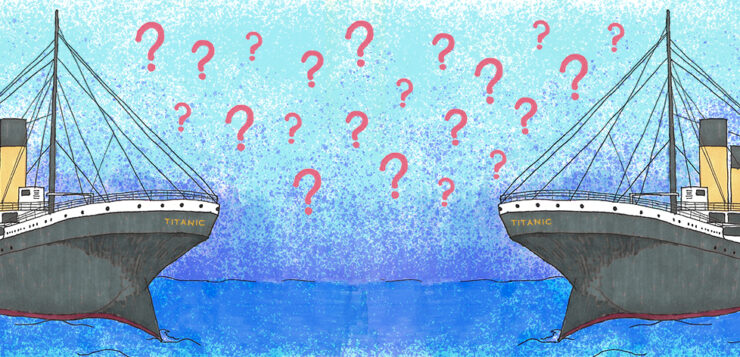We’ve all seen the film. Kate and Leo clutching each other at the prow of the ship, falling in love, his tragic and unnecessary death (there was definitely room for two on that door, Kate). In reality, we all know the story of the Titanic to be a tragic one; the ‘unsinkable’ ship proving to be sinkable after all, leaving 1500 dead in the freezing North Atlantic ocean. Studying in Southampton, it all feels a little closer to home, as this was where the voyage set off, where the passengers kissed their loved ones goodbye with no idea of how permanent that ‘goodbye’ would be. Many of the crew were local to Southampton, so the effects of the disaster were felt intensely in this area, hence the memorial in the city.
But what if we weren’t told the truth? What if a huge secret has been covered up? What if the ‘Titanic’ wasn’t really the ‘Titanic’ at all? Research conducted by Robin Gardiner led him to write a book in 1998, Titanic: The Ship that Never Sank, arguing as such.
The Titanic was owned by the International Mercantile Marine Group, which was under the control of financier J.P Morgan, alongside the White Star Line shipping company. It was him who commissioned the Titanic, as well as two other boats called the Olympic and the Britannic, as luxury liners for his company. The Titanic and the Olympic were almost identical, other than slight differences such as the number of portholes and the spacing of the windows. What set these two boats apart, however, were the issues experienced by the Olympic. In 1911, the Olympic was involved in a collision with a Royal Navy warship at Southampton Water (where our boat balls do their cruises). It sustained a lot of damage and was left permanently leaning slightly to the left. The Olympic was blamed for the accident, meaning that their insurance company would not cover the necessary repairs. This was a disaster for White Star Line, as this meant that the Titanic’s completion date needed to be delayed and the company would experience a devastating financial loss.
The theory claims that J.P Morgan hatched a plan to switch the two ships, meaning that it was actually the Olympic that embarked on that famous journey from Southampton to New York. The plan was for the Titanic, which was now actually the Olympic, to sink deliberately, either inevitably due to its damage or due to tampering by crew members in on the plan. The passenger ship, the SS Californian, which famously failed to respond to the distress signals of the Titanic, was allegedly arranged to be there on standby to rescue the passengers and respond to these distress signals. However, the communications officer fell asleep. The fact that, despite being a passenger ship, the SS Californian’s cargo was only 3,000 woollen blankets and jumpers – but with no onboard passengers – does point to it being there on purpose.
But why do this? What could be gained by risking the lives of all of these passengers? Money, of course. If the “Titanic” sank, the company would receive a hefty sum from their insurance company, as the Titanic was a valuable ship in supposedly perfect condition. This money would be enough to pay for a brand new boat, and possibly more, thus resolving the financial disaster faced by the company.
Why should we believe this? Admittedly it does seem a little far-fetched, however there are some very compelling pieces of evidence.
As previously stated, the damage sustained by the Olympic after its collision in 1911 included a “list to port” – in other words, a tilt to the left. This was noticed by many passengers and noted by survivors, including Lawrence Beesley, who was considered a reliable source and penned one of the first books about the disaster.
One of the slight differences between the Olympic and the Titanic was the number of portholes. The Titanic reportedly had 14 and the Olympic had 16, yet photo evidence shows that despite the Titanic having 14 portholes during the final stages of construction, it had 16 when departing for her maiden voyage. The portholes on the Olympic had been observed to be more unevenly spaced than those on the Titanic, but as the “Titanic” prepared for departure, people noted that her portholes looked more unevenly spaced.
Several high profile passengers, including J.P Morgan himself, cancelled their trip at the last minute. Morgan had used illness as an excuse, yet witnesses claimed to have seen him entirely well and happy the day the ship sank. Many of the other prominent passengers who cancelled were connected to Morgan, suggesting he may have warned them not to travel.
The wreck itself somewhat supports this theory, as the letters M and P are visible on the side of the ship, potentially from where the word ‘Olympic’ had been painted over. Furthermore, although the original Titanic had a black undercoat, there is evidence of the grey undercoat of the Olympic on the wreck. It has to be said, however, that the wreck was not found until 1985, so such physical evidence is less believable as it was therefore was exposed to the elements for 73 years before its discovery.
Conspiracy theories are always tricky, as there often is no smoke without fire and yet it seems hard to believe that such a huge secret can be kept for so many years. Personally, I feel compelled to believe this theory, but also remain sceptical. I firmly believe that it is right to question to world around us, to not immediately believe what we are told but to perform our own investigation and establish the facts for ourselves. As for the Titanic, we may never know the full truth about what happened. Either way, it was a terrible tragedy which sustained significant loss of life and must never be forgotten.




